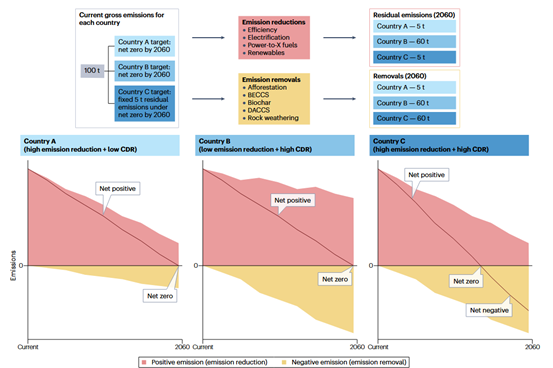Carbon Dioxide Removal (CDR) plays a critical role in achieving global net-zero goals, yet over-reliance on CDR technologies may undermine decarbonization incentives for high-emission industries, such as slowing the transition from fossil fuels to renewable energy. However, abandoning CDR would render the Paris Agreement's 1.5°C warming target unattainable. Professor Liu Haifeng from the School of Mechanical Engineering of Guangxi University and Professor Jin Chao from the School of Environmental Science and Engineering of Tianjin University have developed a "parallel targets" strategy for carbon neutrality using the Global Change Analysis Model (GCAM). This approach independently sets emission reduction targets at source and CDR deployment goals while clarifying their distinct contributions, demonstrating that CDR can synergize with rapid decarbonization to accelerate net-zero/net-negative emissions and shorten the temperature overshoot period. It further dispels longstanding concerns that CDR deployment might prolong fossil fuel use or delay decarbonization. Their study, entitled "Scaling carbon removal without delaying emission reductions," has been published in Nature Reviews Clean Technology (https://doi.org/10.1038/s44359-025-00081-x), with both professors serving as co-corresponding authors.

Effective policy design is essential to simultaneously scale investment and deployment of Carbon Dioxide Removal (CDR) while preventing carbon lock-in and delayed emission reductions. Figure 1 illustrates two policy frameworks proposed in this study to achieve this dual objective.
Under the first policy design where both Country A and Country B implement net-zero policies without clearly defining contributions from emission reductions at source versus Carbon Dioxide Removal (CDR), CDR risks becoming a substitute for decarbonization. Country B, relying more heavily on CDR, demonstrates slower decarbonization progress than Country A. Although both nations may achieve net-zero targets, the lack of explicit differentiation between source-level emission cuts and CDR allows governments to postpone decarbonization efforts—potentially over-relying on future economically viable carbon removal technologies—thus resulting in significantly higher residual emissions in Country B compared to Country A.
The second policy design incorporates fixed emission reduction targets at source (separate from CDR quotas), ensuring parallel CDR deployment serves as a supplement rather than a substitute for decarbonization. Under this framework, nations may freely adopt high- or low-CDR pathways provided deployed removal capacities meet net-zero objectives. While both Country A and Country C reach identical residual emission levels by 2060, Country C’s proactive CDR deployment enables earlier achievement of net-zero status and transition to net-negative emissions. Consequently, CDR may either delay decarbonization and prolong the overshoot duration or—when combined with rapid emissions cuts—function as a pivotal tool to accelerate net-zero/net-negative transitions and shorten the temperature overshoot period.
The article notes that while the "parallel targets" strategy avoids delaying decarbonization, its effective implementation requires overcoming multiple challenges: integrating CDR credits into compliance carbon markets may extend fossil fuel usage cycles. Countermeasures include establishing separate carbon trading markets for CDR credits and emission reduction allowances; lowering the overall market cap when both credit types coexist based on projected CDR contributions; creating intermediary bodies like carbon central banks to independently monitor removal certificate volumes; and implementing temporal mechanisms for negative emission financing to scale carbon removal while ensuring total emission reduction integrity.
Furthermore, expectations about future accessibility of CDR technologies may incentivize nations to postpone near-term high-cost emission reductions. To mitigate this risk, the study recommends implementing phased targets that bind incremental decarbonization milestones and CDR deployment goals to equitable allocations of remaining carbon budgets, while clarifying accountability boundaries through explicit temporal division of responsibilities—establishing concrete accountability mechanisms for emissions cuts and CDR implementation per phase, distinct from ambiguous net-zero objectives without defined task distribution.
Additionally, the article recommends that nations develop diversified CDR portfolios to mitigate target non-compliance risks by avoiding over-reliance on single-technology solutions; and advance cross-border collaboration aligned with national resource endowments and economic conditions. Specifically, economically advanced but resource-constrained countries could invest in low-cost CDR projects within resource-rich regions to meet their targets, while utilizing fiscal transfers to simultaneously stimulate socioeconomic development in host regions.
Finally, strategically leveraging emerging policy instruments—such as Emission Liability Management (ELM), removal certificates, deposit-refund schemes for carbon removal, and Carbon Removal Obligations (CRO)—can accelerate emission reductions while providing upfront financing to scale carbon removal deployment.